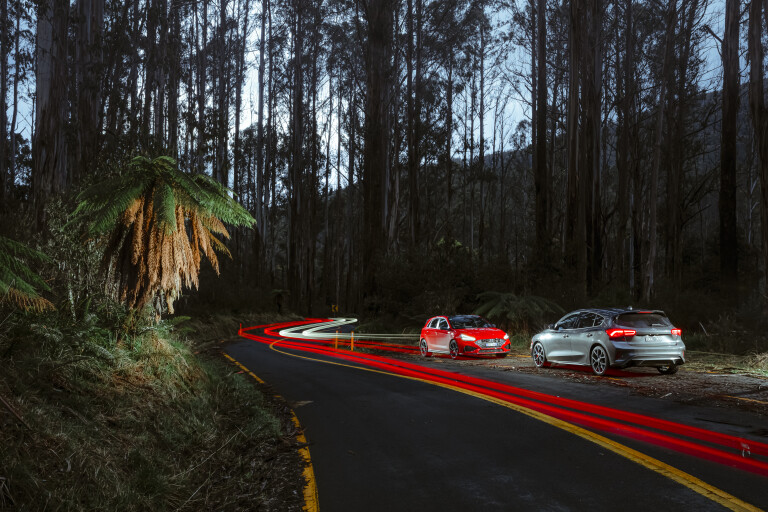
Is there anything more tedious, in the entire automotive firmament, than a manual gearbox fundamentalist? These absolutists are up there with swivel-eyed Elon Musk jocksniffers and pedants who can only find true happiness in informing you that you’re cleaning your car incorrectly.
A true manual gearbox fundamentalist will never accept that there are times when an automatic transmission makes more sense because a manual is just better, obviously. End of.
Blissfully unencumbered by the shackles of nuance yet armed with an encyclopaedic repertoire of 20-year-old Clarkson rejoinders, they’d hate the two cars lined up before us. Because, they’d know that of all the genres of cars that need manual gearboxes, hot hatches are right at the top of that pile, nosing just ahead of Everything Else. And, for a while, all was good with the Hyundai i30 N.

When the Koreans launched the original version back in 2017, a six-speed manual was the sole transmission choice. It was a good ‘un too, slick and wristy with an auto-blip function if your heel-and-toe downchanges needed some polishing.
We’ve all seen the stats though. Only around 3 per cent of Australian cars are sold with manual gearboxes, so if Hyundai wanted to broaden the appeal of the i30 N, something clearly needed to be done.
Just not very quickly. Fast forward four years and we now have the eight-speed dual-clutch version of the i30 N. That would be worthy of note if that was all that had happened to the i30 N, but it isn’t.
On the sly, Hyundai has been through the car, effecting some fairly fundamental changes. Most obviously, the car has been treated to a bit of Botox, with updated LED lights and a revised grille.
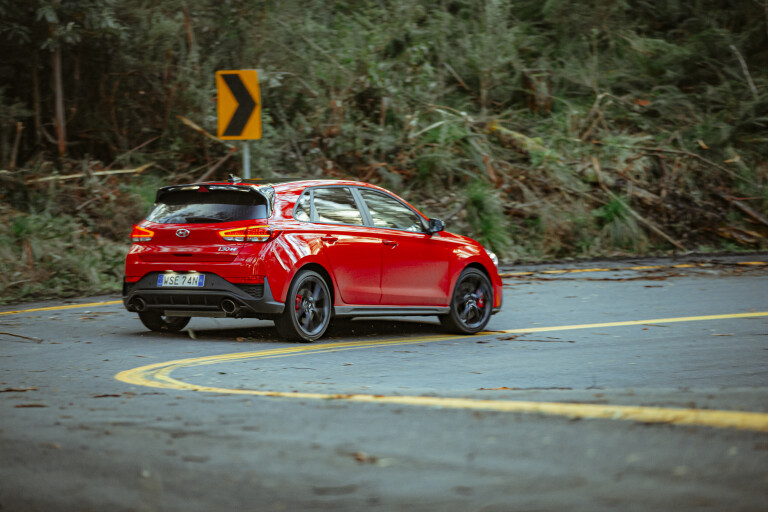
More significantly, the 2.0-litre T-GDi four-cylinder engine has been given a massage, releasing an additional 4kW for a total of 206kW and a hefty torque bump of 39Nm to 392Nm. The updated engine mapping promises a ‘flat power’ philosophy, but the old motor made its 353Nm peak torque figure from just 1450rpm, both tailing off at 4700rpm.
Thanks to its launch control and almost instant upshifts, the DCT version is markedly quicker from a standing start than the manual, shaving half a second of the three-pedal car’s 0-100km/h time, recording a crisp 5.4 seconds.
Rather than merely plug a laptop and the cleverest kid the N Division could find into the i30 N DCT, Hyundai has applied itself a little more diligently. The engine block has been strengthened courtesy of smarter machining techniques, the 6.5-litre intercooler is swapped out for a high-flow 6.8-litre item and a larger turbocharger debuts, drawing on development work from Hyundai’s own World Time Attack racer.
There’s more. We’ll come to that later, because Scott Newman has just arrived in a Ford Focus ST automatic. I ask how he likes it. He blows his cheeks out, raises his eyebrows and notes that on the wet roads en route to our Yarra Ranges rendezvous point it’s all been a bit lively. That’s certainly one way to wake up.
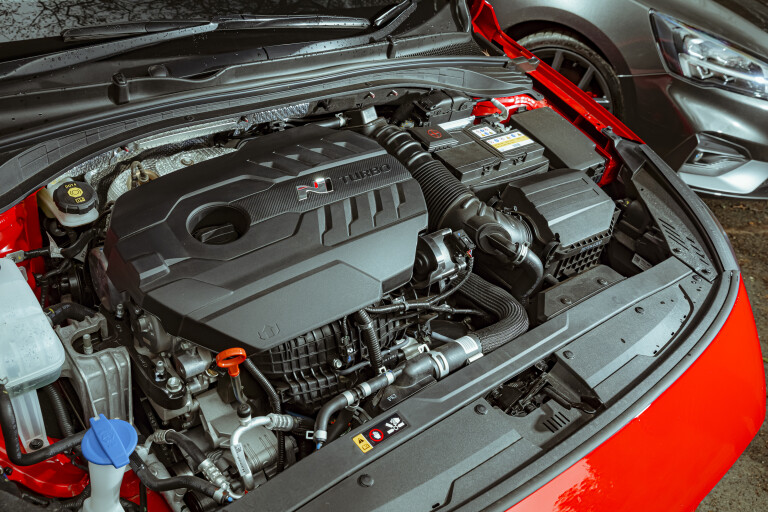
There’s none of the delayed gratification about the auto version of the ST. It was launched at exactly the same time as the manual version and accounts for around 25 per cent of all Focus ST orders. Whereas the i30 N ladles another $3000 on for the privilege of the DCT’s smarts, both manual and automatic Focus STs are priced identically at $44,690.
You be the judge of whether Ford are coining it from the 75 per cent of buyers who choose three pedals. While we tend to mentally pigeonhole the i30 N as a $40k car, this version, the Premium with sunroof wears a $52,000 price tag. Advantage Ford.
At this point, we need to talk weight. The Hyundai i30 N DCT weighs in at 1466kg, with the DCT accounting for 33kg extra over a manual. The Ford tips the scales at 1487kg, of which the torque-converter auto adds 26kg versus the three-pedal version. Hyundai makes great play of taking weight out of the latest i30 N. This Premium model comes with manually adjustable bucket seats that are 2.2kg lighter than the standard seats.
It also gets a new design of forged rather than cast alloy wheels that shaves 3.6kg of unsprung mass from each corner. It’s a shame that this car ruins that good work by sitting a huge pane of glass and a bunch of electric motors above your head, in precisely the worst place from a dynamics perspective. What’s more, it compromises headroom, forcing taller drivers to rake the seat back to fit. Do yourself a favour when choosing an i30 N. Leave the panoramic roof to those buying a Staria.
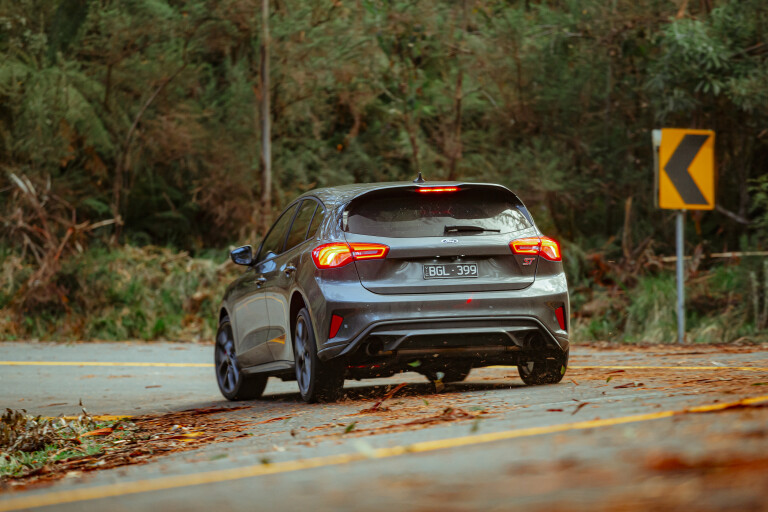
It’s been raining on and off today. It’s the sort of rain that lingers on the road beneath overhanging trees, fine misting your screen to the point where automatic wipers just become an annoyance.
You’ll forget that it’s been raining at times, only to step from the car into a sucking gloop of mud. That sort of rain. Normally that would mean a day spent trying to wear out the traction control light in powerful hatches like these, but both the Focus and the i30 are relishing these ever-changing high country conditions.
The Focus feels more explicitly front-driven. I’m trying to imagine the coding for the electrically adjustable power steering software that feeds back wheel fight under torque steer, a long list of conditions based on disturbance magnitude and direction.
The chubby wheel bucks in your hands as the 235mm-wide front Pilot Sport 4S tyres try gamefully to apportion torque evenly. There’s a slightly gluey feeling just off-centre, a rubbery and strong return to the Focus’ steering that I don’t remember when driving the manual, a car that isn’t fitted with a lane-keep assist system.

An electronically actuated mechanical limited-slip differential is fitted. This utilises an electronically locking clutch that can vary its level of lock in order to sniff out traction.
Make no mistake, in real world conditions, the automatic version of the Focus ST will step off the line quicker than the manual car, despite the fact that Ford has inexplicably not fitted it with a launch control function. It feels brawnier than the Hyundai punching out of corners too, thanks to its objective torque advantage and the subjective wheel fight and gutsy acoustics.
The Hyundai feels a little reedier, the soundtrack a little more synthetic, the steering lighter. There’s not that muscularity or heft to it that the Focus has in spades, but it’s no less effective. The steering, at an identical 2.1 turns lock-to-lock, is more accurate than the Ford’s, allowing you to position the car more confidently.
There’s not much to choose between the two in terms of braking power, but the i30’s left hand pedal is easier to modulate, the ST’s servo assist meaning that it does most of its best work in a short swing of the pedal’s arc. It’s also worth mentioning that if you’re a habitual left-foot braker, the pedal box of the i30 N is preferable as the Ford offsets the two pedals further to the right.
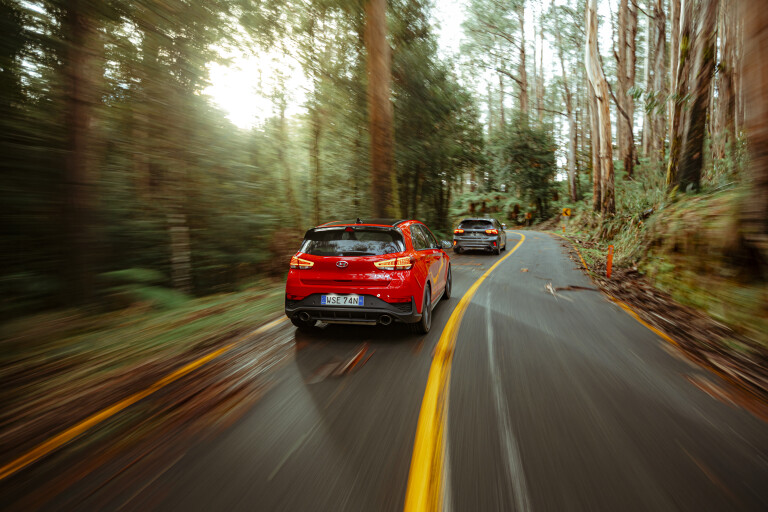
Which of these two very different transmissions works best though? As with most things, the answer is ‘it depends’. Were you to buy the Focus ST to warble about on its bow wave of low-end torque, a trad automatic makes all kinds of sense. And it’s a good installation for that. I’m not anything like as offended by the Focus ST’s rotary gear shifter as I am by one in a Jaguar and it slurs through gears beautifully. Up the ante, however, and a few caveats occur to you.
The drive logic, even when wicked up into Sport mode is a little lazy. Dive into an apex, gather everything up and pin the throttle and you’ll often find yourself in a gear lower than you want.
The acoustics and the ambition don’t match. So you take over the wheel-mounted paddles yourself, flicking the stunted plastic nubs up and down into and out of corners and you come to the conclusion that you’re having a whale of a time, but doing so despite and not because of the transmission.
Would a manual car be more fun? Yes, undeniably. Fizzier, more involving and to heck with it if it’s not quite as sharp as the i30 N.
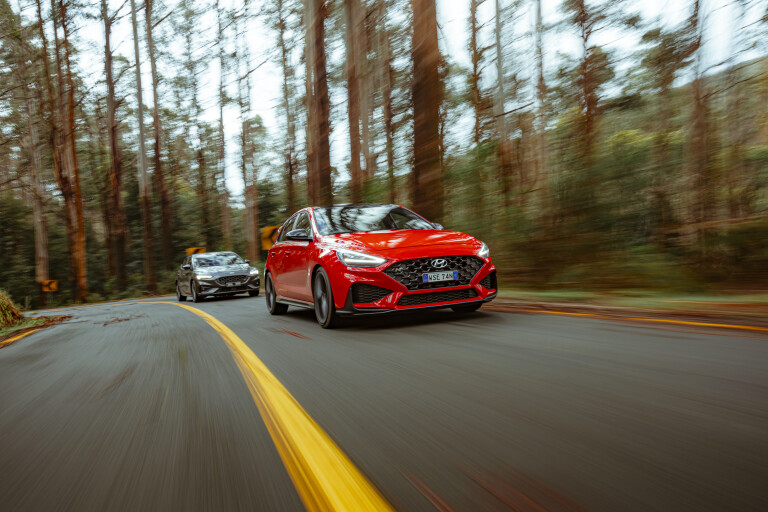
The Hyundai, on the other hand, doesn’t suffer as a result of its ’box. The DCT is whip smart, delivering manual downchanges right up to the redline, where the Focus will build in a safety-first buffer of denial. The Korean car also feels leagues ahead in terms of user choice.
Where the Focus offers Normal, Slippery, Sport and Race drive modes, the Hyundai allows a custom version of its N Mode which is completely user assigned. You can even adjust things on the fly via a ‘spider map’ on the central display. What’s more, the breadth of difference between the i30 N’s most comfortable and most racy modes is so vast that it feels like you’re almost getting two cars for the price of one.
Both of these hatches run on adaptive suspension and, yes, in their most focused mode they can feel a little too firm for poorly surfaced Aussie B-roads. Where the Ford is particularly good, is that the compliance of both the Normal mode and the Sport setting are supple enough to breathe with our roads. There’s real talent in the way the car has enough roll, pitch and dive built in to allow the skilled driver to work weight transfers smartly.
Should you feel so inclined, you can get the ST to lift-off oversteer sharply on the way into corners. Sounds obvious but unlike a wiggle of power oversteer on the way out of a corner, getting out of shape on the way in leaves you a corner to then negotiate and not a straight. Treat the stability control button with the respect it deserves.
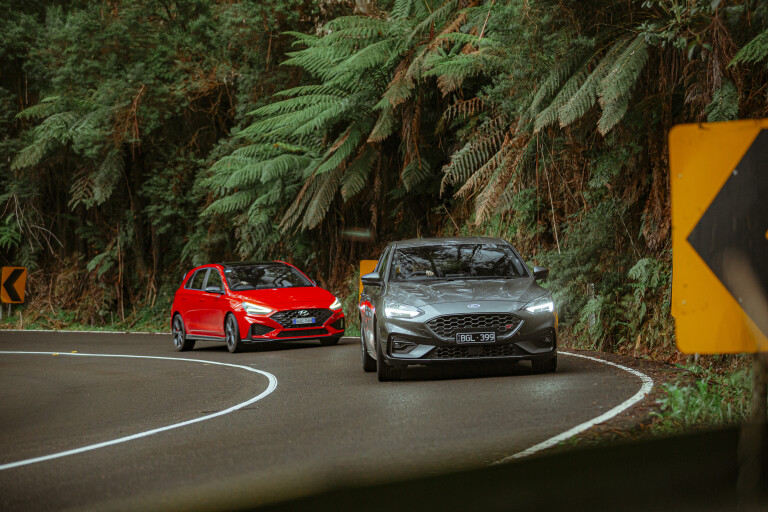
By contrast, the Hyundai i30 N feels flatter and harder in its base setup. You feel as if you can take outrageous liberties with it and in N Mode, the stability control will allow a measure of off-throttle yaw before it decides that perhaps you need saving from yourself.
It would be enormous fun on track though, and Hyundai’s track-ready warranty means that it’s a bit of a no-brainer if you’re trying to choose between these two for weekend circuit excursions.
On road, the Hyundai feels more nimble, the slightly weighty feeling of the old i30 N being massaged away courtesy of a suite of suspension changes that make it feel more sprightly.
N Division has gifted the latest car spring rates that are 5.7 per cent stiffer up front and 4.2 per cent beefier at the rear, revalved dampers, revised rear toe-arms, new bump stops plus redesigned front knuckles and lower control arms that result in additional negative camber at the front.

The volume of the exhaust is something to behold, the fusillade of bangs and crackles on overrun being a signature aspect of the original i30 N. That continues with this model. On a mountain road, an approaching i30 N still sounds like Dani Sordo at maximum attack on a special stage.
The N is one of those rare cars which seems to feel better and happier the harder you drive it. You can forgive its low speed truculence and its woeful turning circle just for the moments when you’re able to really extend it. Then you see where Albert Biermann and his team spent the budget.
The new N functions fitted to this are worthy of note. N Power Shift detects when an upshift is asked for when more than 90 per cent of throttle is applied and does its best to imitate the smack of a Lambo’s Corsa upshifts. N Track Sense Shift recognises when you’re driving on track and selects the most aggressive gearshifting map available.
Finally, the execrably titled N Grin Shift, operated via the NGS button on the wheel, gives you a slightly cheesy 20 second countdown with the car dialled into its angriest setting and is designed for executing safe overtaking manoeuvres.
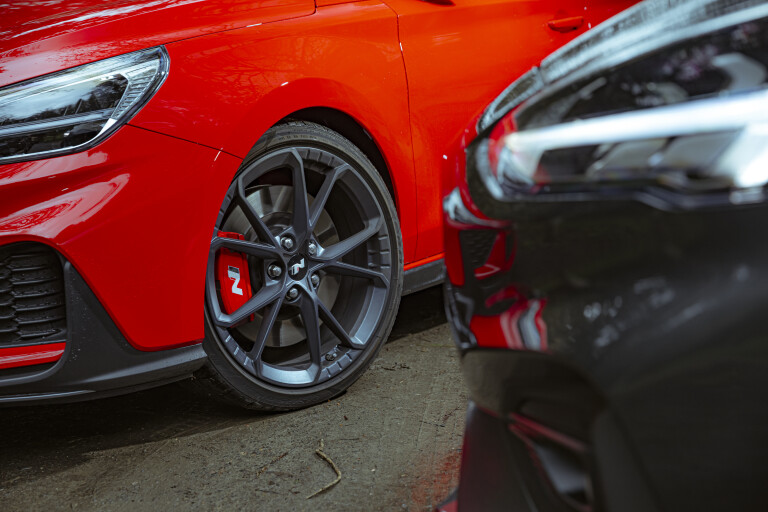
By now you’ll have probably keyed into the fact that the Hyundai i30 N DCT does enough to edge the win here. It’s the more talented car for really keen drivers.
Should you test one and feel that Hyundai’s needle has swung a little too far into the rabid zone, the Focus ST makes a compelling Plan B. That ignores the fact that the i30 N is enhanced by the DCT ’box and the Focus ST loses a little of its magic when shorn of a pedal.
Given the price advantage of the Ford, it pushes the Hyundai close, but Namyang has moved the game on here. Manual gearbox fundamentalists can address the poison pen letters to the usual address.
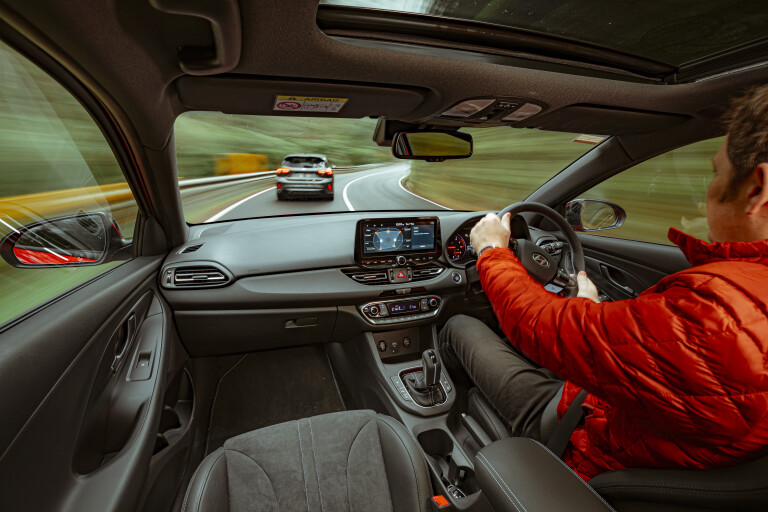
Clutch move
Hyundai has engineered a wet clutch system for its DCT installation on the i30 N. While dry clutch systems are typically used for lower torque applications, the lubricated components of a wet clutch DCT help reduce friction and dissipate heat. Therefore this technical solution is increasingly favoured in any application where thermal robustness and durable shift quality is prioritised.
Wet clutch DCTs can then be divided into those systems that feature a single sump to lubricate both the gears and the clutch and those with a dedicated oil supply to each component. Single sump wet clutch installations require a fluid that combines the gear protection of manual transmission fluid with the clutch friction performance of automatic transmission fluid, balancing torque capacity and shudder durability.

Boxing clever
The Focus ST’s seven-speed auto shares virtually everything with Ford’s pre-existing eight-speed unit, as seen in products such as the Ford Edge. In effect, Ford has installed a software parameter that forces the ST to overlook the eight-speed’s second gear.
Surely more gears mean more performance? Not so, says Ford of Europe’s communications manager Finn Thomasen. “The enhanced power and torque of the 2.3-litre EcoBoost engine makes the standard second gear ratio redundant, therefore it is removed for the Focus ST to optimise gear differentiation for performance.”
SCORING
i30 N DCT: 9/10
Focus ST auto: 8/10

2022 Hyundai i30 N DCT specs
| Body: | 5-door, 5-seat hatch |
|---|---|
| Drive: | front-wheel |
| Engine: | 1998cc inline-4, DOHC, 16v, turbo |
| Bore/stroke: | 86.0 x 86.0mm |
| Compression: | 9.5:1 |
| Power: | 206kW @ 6000rpm |
| Torque: | 392Nm @ 2100-4700rpm |
| Power/Weight: | 141kW/tonne |
| 0-100km/h: | 5.4sec (claimed) |
| Weight: | 1466kg |
| Transmission: | 8-speed dual-clutch auto |
| Suspension: | struts, coil springs, adaptive dampers, anti-roll bar (f) multi-link, coil springs, adaptive dampers, anti-roll bar (r) |
| L/W/H: | 4455/1795/1419mm |
| Wheelbase: | 2650mm |
| Tracks: | 1573/1564mm |
| Steering: | electrically assisted rack-and-pinion |
| Brakes: | 360mm ventilated discs, 4-piston calipers (f); 314mm solid discs, single-piston caliper (r) |
| Wheels: | 19 x 8.0-inch (f/r) |
| Tyres: | 235/35 R19 91Y (f/r) Pirelli P Zero HN |
| Pros: | Sharp dynamics; quicksilver DCT; clever drive modes |
| Cons: | Firm ride; getting expensive; pop-bang map can be divisive |
| Price: | $52,000RRP (Premium with sunroof) |
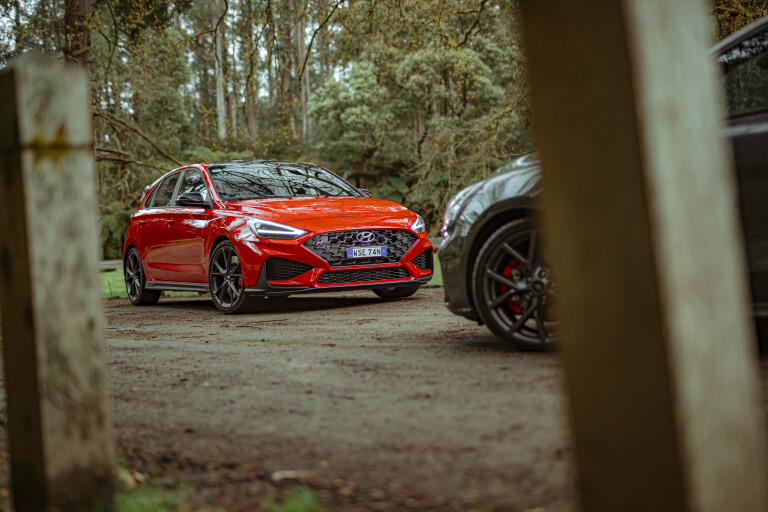
2022 Ford Focus ST Auto specs
| Body: | 5-door, 5-seat hatch |
|---|---|
| Drive: | front-wheel |
| Engine: | 2261cc inline-4, DOHC, 16v, turbo |
| Bore/stroke: | 87.5 x 94.0mm |
| Compression: | 9.7:1 |
| Power: | 206kW @ 5500rpm |
| Torque: | 420Nm @ 3000-4000rpm |
| Power/Weight: | 139kW/tonne |
| 0-100km/h: | 5.9sec (claimed) |
| Weight: | 1487kg |
| Transmission: | 7-speed auto |
| Suspension: | struts, coil springs, adaptive dampers, anti-roll bar (f) multi-links, coil springs, adaptive dampers, anti-roll bar (r) |
| L/W/H: | L/W/H: 4388/1825/1458mm |
| Wheelbase: | 2700mm |
| Tracks: | 1561/1566mm |
| Steering: | electrically assisted rack-and-pinion |
| Brakes: | 330mm ventilated discs, 4-piston calipers (f); 302mm ventilated discs, single-piston caliper (r) |
| Wheels: | 19 x 8.0-inch (f/r) |
| Tyres: | 235/35 ZR19 91Y (f/r) Michelin Pilot Sport 4S |
| Pros: | Gutsy engine; great ride; mid-corner adjustability; pricing |
| Cons: | Auto drive logic; cabin refinement; manual feels smarter |
| Price: | $44,690 RRP |
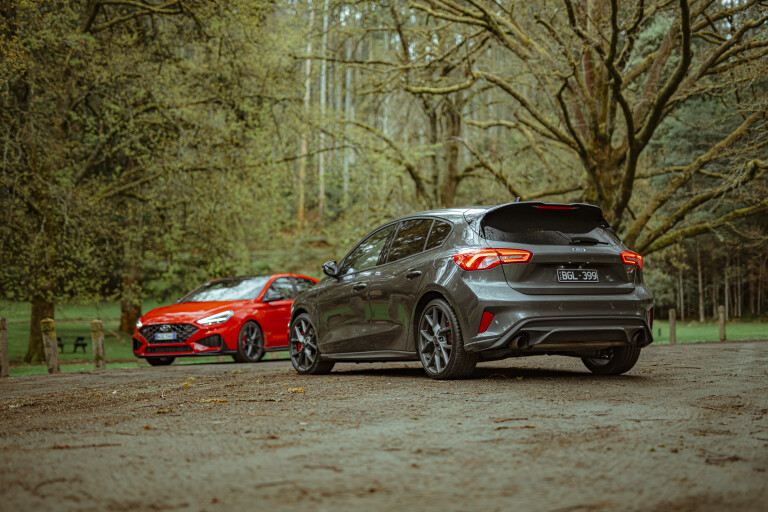



COMMENTS